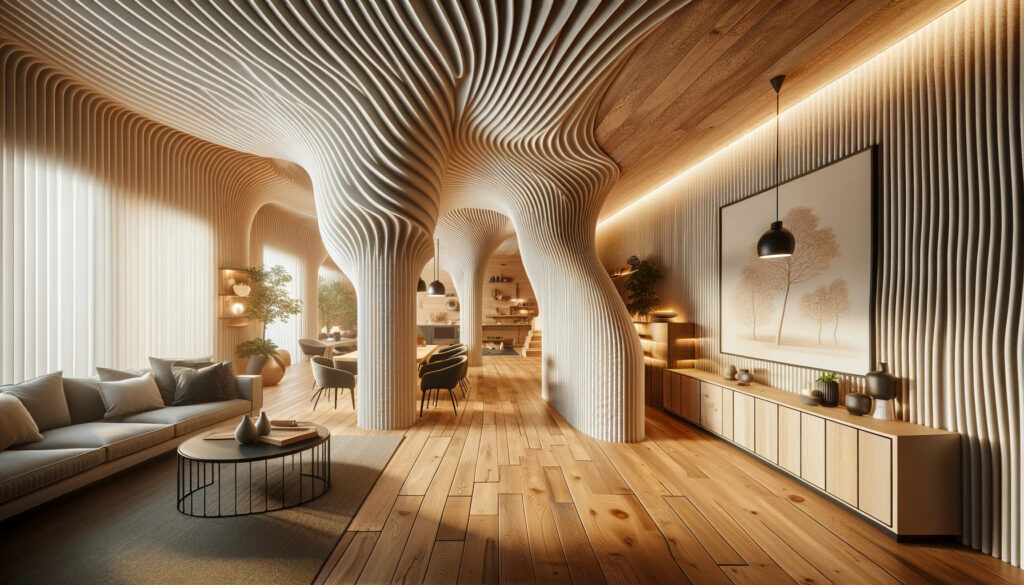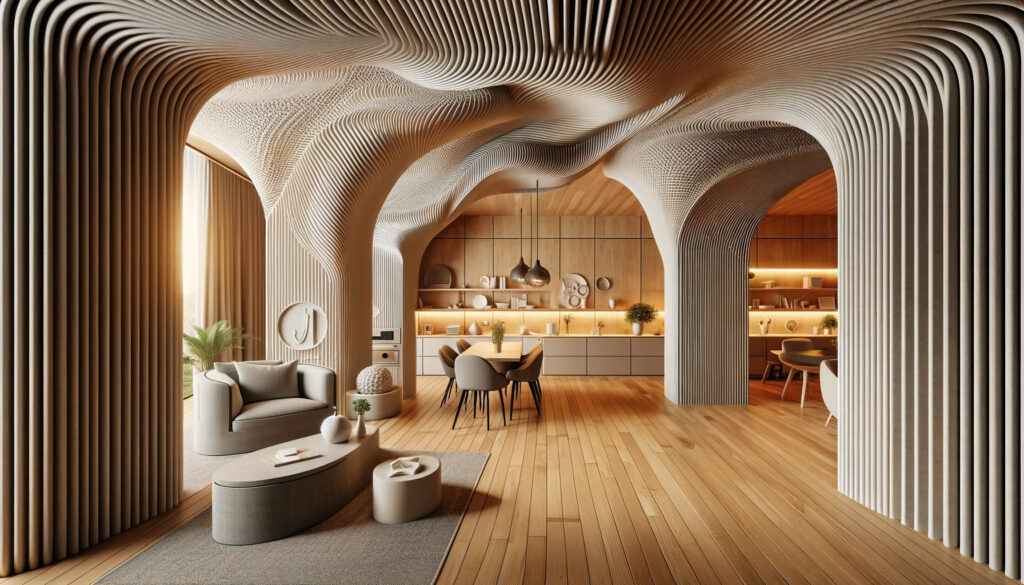3D printing technology has advanced rapidly in recent years, allowing for the creation of full-scale printed structures like houses and bridges. As the technology continues to progress, 3D printed homes are poised to transform the construction industry.
A Brief History of 3D Printed Construction
The idea of using 3D printing for construction is not new – it traces back to innovations in the 1950s. However, major advancements have occurred in the last decade.
1) The development of 3D printed houses started with small-scale prototypes and models.
2) Recent years have seen full-scale printed dwellings like an entire home printed in Germany and large multi-family units under construction.
3) By 2030 major goals are in place to use 3D printing for 25% of new building construction in some countries.
Despite these achievements, the widespread adoption as a mainstream building technique has yet to occur. But this emerging technology shows strong potential for disrupting current practices.
How 3D Printed Home Construction Works
Constructing a dwelling with 3D printing involves specialized equipment and preparation.
The Printing Process
Constructing a house with 3D printing starts by transporting large, specialized printers to the building site. These robotic printers can be self-contained units housed in shipping containers, or modular systems assembled on-site. Setup of the equipment is fast – some companies boast being operational within 30 minutes using just a couple operators.
1) The printers function by depositing material layer-by-layer based on a pre-programmed digital model to fabricate structural components.
2) Walls are built up through repeated passes of the print head ejecting the printed medium precisely as the gantry moves across the planned floorplan.
3) Horizontal layers are stacked until forms like walls and columns reach the desired heights.
4) Prints can progress rapidly in some systems – upwards of 1 meter per second.
5) Meanwhile, the automated nature of the technique means very little manual labor is required during the building process.
6) Monitoring teams can oversee the equipment and ensure smooth running rather than actively working on construction.
Post-print, parts like the foundation and roof may still need traditional construction techniques. Interior finishing work and integration of electrical/plumbing systems also necessitates some conventional tradespeople. However, the ease of producing the printed shell is a major advantage.

Materials and Design
A key benefit 3D printing offers is flexibility – both in possible materials used and the geometries that can be fabricated.
The most common medium is concrete due to its strength and durability when cured. But early projects have shown potential for alternative printable building materials like clay composites, sand mixtures, or materials using local natural resources like soil or straw. Complex proprietary blends continue to be developed. This range of material choices allows cost and sustainability optimization on a project basis.
Additionally, 3D printing frees designs from rectilinear restrictions and uniform layouts. Floorplans can feature curves, sloped walls, custom indentations – virtually any shape imaginable. And the automated printing process efficiently handles the complexity without increased effort. This allows completely customized house geometries tailored to client needs and preferences without design constraints.
The technology has also enabled innovations like integrated utility conduits within printed walls, homes optimized for solar gain, and designs catering to disabilities or aging-in-place. Specialized applications are also being explored like disaster relief shelters, sustainable tiny homes, and off-grid housing with a small footprint. The flexibility of 3D printing is key for these unique use cases.

Click here to learn more and subscribe to the newsletter
The Future Impact of 3D Printed Dwellings
As the technology matures, 3D printing promises to transform residential construction and provide other societal benefits:
Streamlining Housing Creation
3D printing promises to transform home building by accelerating timelines and reducing construction costs on a large scale. This combination of speed and lower cost provides a solution to address housing shortages globally.
Faster – By automating construction, 3D printing accelerates home building. Constructing the structural shell takes days rather than weeks or months.
Lower-cost – Less manual labor is needed. Operator counts can be as low as 2 people. There is less need for skilled tradespeople.
Scalable – Eliminating manual tasks enables rapid fabrication of quality housing at scale to address shortages.
Sustainable Construction
3D printing enables more eco-friendly and optimized construction methods aligning with environmental initiatives. The ability to print locally while minimizing material use and integrating renewables results in a smaller carbon footprint.
Eco-friendly – Printing on-site with local, recycled materials like soil or straw cuts emissions and waste.
Optimized – Printing only essential components prevents overbuilding and material waste.
Renewable – Integration of solar panels and passive ventilation further diminishes footprint.
Affordable Housing Options
Creative 3D printing innovations could enable distinctive small-scale dwellings to be broadly affordable to everyday homebuyers. Small and simple printed homes have demonstrated livable spaces at remarkably low price points.
Lower price tags – Small printed homes have demonstrated livable dwellings for $1000. Continued improvements will further reduce costs.
Mass customization – Easy customization facilitates creative tiny homes, accessory dwellings, and transitional shelters.
In reach – Unique housing solutions once only for the wealthy could realistically be affordable for everyday homebuyers.
Get your free “2024 Real Estate Market Outlook” now!
3D Printed Neighborhood Showcases the Future
The world’s largest 3D printed neighborhood taking shape in Georgetown, Texas provides a vision of the future for residential construction. The 100-home community is a collaboration between builders ICON and Lennar along with architecture firm Bjarke Ingels Group (BIG). Their first printed home was recently unveiled to much fanfare.
The single-story gray structure features walls printed from Lavacrete – ICON’s proprietary concrete composite mix. The material is precisely deposited by a specialized 3D printer on an extending robotic arm. The automated technique fabricated the home’s walls in just a matter of days. After printing, the roof, doors, windows and other elements were then installed to finish the dwelling.
Over a third of the community’s homes have had their major wall structures printed so far. The properties are priced between $475,000 to $599,000, with flexible floorplans ranging from 1,500 to 2,100 square feet across 3-4 bedrooms.
Showcasing the Potential
As an entire neighborhood taking shape, the audacious Texas project provides proof-of-concept for 3D printing on a grand scale. Some specific advantages showcased include:
Speed – Walls and structures printed rapidly with no lengthy framing or masonry work. This acceleration can help address housing deficits.
Quality – Precise robotic printing may improve consistency and material performance.
Sustainability – Concrete printing methods reduce waste and emissions. Further optimizations are possible.
Affordability – Automation and optimizations cut costs now, with projected future savings as the technology scales up.
Appeal – Modern geometric patterns and textures printed directly onto concrete surfaces create designer aesthetics.
However, some downsides exist too – printed homes may still rely on carbon-intensive concrete as the primary building material. Energy demands of running the large printers also necessitate consideration.
Paving the Way
As an iconic demonstration project, the Texas neighborhood is paving the way for larger adoption of 3D printing in residential construction. The community will provide data to analyze the practicality of printing homes en masse. Developer ICON itself aims to print over 1,000 homes in the next 5 years.
If even a fraction of new homes employ printed techniques going forward, it would transform building practices worldwide. The Texas community offers an exciting vision of what future housing could look like. The printed homes may soon be the norm rather than the exception.
Conclusion
As 3D printing technology continues to progress in the coming years, a revolution in how residential buildings are constructed is on the horizon. The transformative impact promises to accelerate project timelines significantly while reducing costs through automation. At the same time, customized fabrication abilities support sustainable practices and expand housing accessibility. While mainstream adoption is still ramping up, bold demonstration projects like the 3D printed Texas community prove the technology’s viability for large-scale disruption. Construction industries worldwide are poised for radical shifts as 3D printing progresses from novelty technique to new standard practice. With so much potential, 3D printed homes seem certain to play a vital role shaping the future of human dwellings around the globe.
Interested in multifamily real estate investing? Our experienced team is here to help. From market research to identifying the best opportunities, we guide you through the process. Subscribe to our YouTube channel for informative videos and expert discussions, and follow us on Instagram for exclusive content. Explore our comprehensive Udemy course for detailed insights and strategies. Ready to elevate your investment journey? Contact us now to schedule a consultation and achieve your financial goals in real estate.
*This content is for informational purposes only and is not intended as financial or legal advice. Please consult with a professional advisor before making any investment decisions.



























